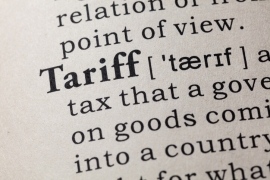Archived article
Please note that tax, investment, pension and ISA rules can change and the information and any views contained in this article may now be inaccurate.

The popular perception among most investors at the start of 2025 was that Donald Trump’s bark was worse than his bite – in other words, some of the more outlandish promises he made on the hustings were unlikely to translate into actual policies.
Three weeks after the inauguration, that assumption has already been tossed out of the window as one announcement after another caused market disruption.
During 72 hours of volatile trading, Trump announced 25% tariffs on Canada and Mexico, then rowed back from them while imposing a 10% tariff on Chinese goods, before proposing the US take control of Gaza and launch a ‘riviera’ development programme.
Yet, since Tuesday, US markets have been on what one observer called ‘a merry-go-round of optimism’, with 10-year bond yields dropping following the release of two distinctly unimpressive economic reports, the PMI and ISM surveys, suggesting we are back in ‘bad news is good news’ territory.
Amazon
Like other ‘Magnificent Seven’ stocks, investors don’t quite now what to make of latest earnings from Amazon, weighing more massive AI capex versus a margin expansion story of a fundamentally sound business.
You can see why. It expects to invest up to $100 billion this year, the majority of that on AI for its cloud division, AWS, with more data centres, hardware, chips and networking gear to further lay the foundations to serve what it expects to be a gigantic wave of demand.
The company insists it wouldn’t spend that money unless it was certain that customers will be lining up to buy its services and is even predicting that virtually every application that exists today will be reinvented with AI at the heart.
But it’s a huge outlay and when or if will the returns roll in, is clearly on the market’s collective mind. Guidance for $151 billion to $155.5 billion net sales in the current quarter was on the soft side ($158.5 billion was the market forecast) and operating profits look likely to be flat this year, so later rather than sooner might be the answer.
Still, Amazon has been here before, carving new growth fronts that take time to mature, and its’ previous success has earned it time and patience. The stock was soft in response to this latest report, losing about 3%, but it is up 11% over the past three months, 42% over six, and 130% higher over the past five years.
Mondelez & Hershey
Cocoa price inflation continues to loom large over global chocolate makers. This week, shares in Mondelez soured in after-hours trading after the snacking giant’s fourth quarter sales and earnings (4 February) missed estimates, though the stock clawed back losses to close the week 1.3% to the good at $57.8.
Fourth quarter sales sweetened up 3.1% to $9.6 billion, but this was light of the $9.64 billion analysts were looking for, while a 16% drop in adjusted earnings per share (EPS) to $0.65 proved worse than the $0.66 consensus estimate.
Dirk Van de Put-led Mondelez, whose iconic brands include Oreo and Cadbury Dairy Milk, now expects adjusted EPS for full year 2025 to be down roughly 10% due to the ‘unprecedented’ cocoa cost inflation that has forced Mondelez to raise prices and dampened volumes.
Shares in US confectionery rival Hershey, which reportedly spurned a second takeover bid in a decade from Mondelez last year, finished the week 2% higher at $152.3 off the back of forecast-beating fourth quarter results (6 February). EPS of $2.69 came in ahead of the $2.37 Wall Street was looking for as quarterly sales grew 8.7% to $2.89 billion at the Hershey’s-to-Reese’s maker, topping the $2.84 billion consensus estimate. Echoing the concerns of her Mondelez counterpart, CEO Michele Buck warned the surge in cocoa prices will put ‘significant pressure’ on Hershey’s 2025 earnings.
Mattel
Shares in Mattel gained a healthy 13% this week as the US toy maker’s full year profit forecast beat Wall Street analysts’ expectations. Over the past year the toy making giant’s shares have gained 15% to sit at the $21.46 mark.
The maker of Barbie reported a 2% rise in net sales to $1.64 billion for the fourth quarter (4 February) and adjusted EBITDA (earnings before interest taxation depreciation and amortisation) of $249 million, an improvement of $15 million.
It is not hard to see why the company is in jubilant mode. According to Anthony DiSilvestro, Mattel’s CFO it is ‘tracking ahead’ of schedule to achieve its $200 million cost savings target by the end of 2026.
‘Mattel’s 2025 guidance includes our expectation to grow top and bottom line, increase investments in digital games, and repurchase $600 million of shares,’ added DiSilvestro.
The Hot Wheels manufacturer’s latest set of results buck the trend of slower sales in the toy industry last year due to weak consumer confidence.
Mattel did however signal a note of caution over president Trump’s commitment to tariffs on China, Canada and Mexico which might cause product price increases for the company going forward.
Ways to help you invest your money
Put your money to work with our range of investment accounts. Choose from ISAs, pensions, and more.
Let us give you a hand choosing investments. From managed funds to favourite picks, we’re here to help.
Our investment experts share their knowledge on how to keep your money working hard.
Related content
- Fri, 13/06/2025 - 11:30
- Mon, 09/06/2025 - 10:43
- Fri, 06/06/2025 - 11:25
- Fri, 30/05/2025 - 13:55

